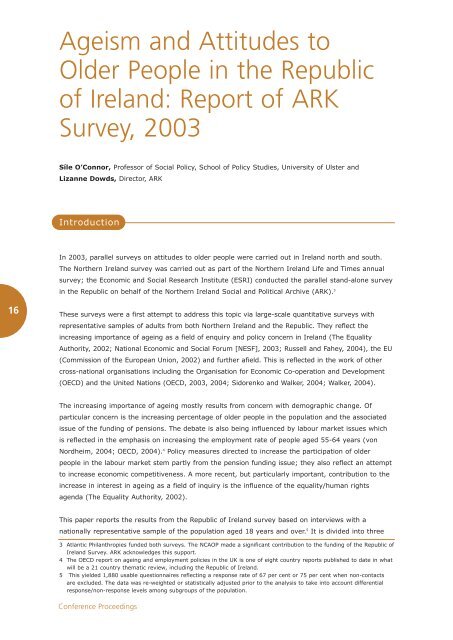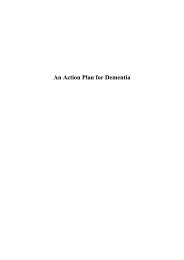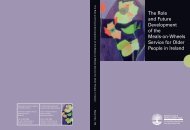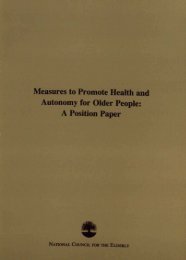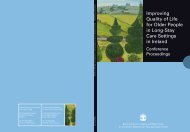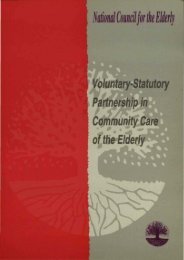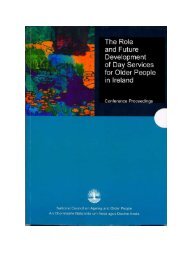From Ageism to Age Equality: Addressing the Challenges ...
From Ageism to Age Equality: Addressing the Challenges ...
From Ageism to Age Equality: Addressing the Challenges ...
You also want an ePaper? Increase the reach of your titles
YUMPU automatically turns print PDFs into web optimized ePapers that Google loves.
<strong><strong>Age</strong>ism</strong> and Attitudes <strong>to</strong>Older People in <strong>the</strong> Republicof Ireland: Report of ARKSurvey, 2003Síle O’Connor, Professor of Social Policy, School of Policy Studies, University of Ulster andLizanne Dowds, Direc<strong>to</strong>r, ARKIntroductionIn 2003, parallel surveys on attitudes <strong>to</strong> older people were carried out in Ireland north and south.The Nor<strong>the</strong>rn Ireland survey was carried out as part of <strong>the</strong> Nor<strong>the</strong>rn Ireland Life and Times annualsurvey; <strong>the</strong> Economic and Social Research Institute (ESRI) conducted <strong>the</strong> parallel stand-alone surveyin <strong>the</strong> Republic on behalf of <strong>the</strong> Nor<strong>the</strong>rn Ireland Social and Political Archive (ARK). 316These surveys were a first attempt <strong>to</strong> address this <strong>to</strong>pic via large-scale quantitative surveys withrepresentative samples of adults from both Nor<strong>the</strong>rn Ireland and <strong>the</strong> Republic. They reflect <strong>the</strong>increasing importance of ageing as a field of enquiry and policy concern in Ireland (The <strong>Equality</strong>Authority, 2002; National Economic and Social Forum [NESF], 2003; Russell and Fahey, 2004), <strong>the</strong> EU(Commission of <strong>the</strong> European Union, 2002) and fur<strong>the</strong>r afield. This is reflected in <strong>the</strong> work of o<strong>the</strong>rcross-national organisations including <strong>the</strong> Organisation for Economic Co-operation and Development(OECD) and <strong>the</strong> United Nations (OECD, 2003, 2004; Sidorenko and Walker, 2004; Walker, 2004).The increasing importance of ageing mostly results from concern with demographic change. Ofparticular concern is <strong>the</strong> increasing percentage of older people in <strong>the</strong> population and <strong>the</strong> associatedissue of <strong>the</strong> funding of pensions. The debate is also being influenced by labour market issues whichis reflected in <strong>the</strong> emphasis on increasing <strong>the</strong> employment rate of people aged 55-64 years (vonNordheim, 2004; OECD, 2004). 4 Policy measures directed <strong>to</strong> increase <strong>the</strong> participation of olderpeople in <strong>the</strong> labour market stem partly from <strong>the</strong> pension funding issue; <strong>the</strong>y also reflect an attempt<strong>to</strong> increase economic competitiveness. A more recent, but particularly important, contribution <strong>to</strong> <strong>the</strong>increase in interest in ageing as a field of inquiry is <strong>the</strong> influence of <strong>the</strong> equality/human rightsagenda (The <strong>Equality</strong> Authority, 2002).This paper reports <strong>the</strong> results from <strong>the</strong> Republic of Ireland survey based on interviews with anationally representative sample of <strong>the</strong> population aged 18 years and over. 5 It is divided in<strong>to</strong> three3 Atlantic Philanthropies funded both surveys. The NCAOP made a significant contribution <strong>to</strong> <strong>the</strong> funding of <strong>the</strong> Republic ofIreland Survey. ARK acknowledges this support.4 The OECD report on ageing and employment policies in <strong>the</strong> UK is one of eight country reports published <strong>to</strong> date in whatwill be a 21 country <strong>the</strong>matic review, including <strong>the</strong> Republic of Ireland.5 This yielded 1,880 usable questionnaires reflecting a response rate of 67 per cent or 75 per cent when non-contactsare excluded. The data was re-weighted or statistically adjusted prior <strong>to</strong> <strong>the</strong> analysis <strong>to</strong> take in<strong>to</strong> account differentialresponse/non-response levels among subgroups of <strong>the</strong> population.Conference Proceedings


